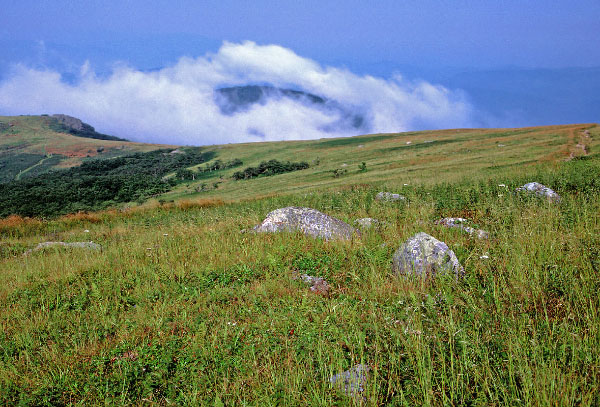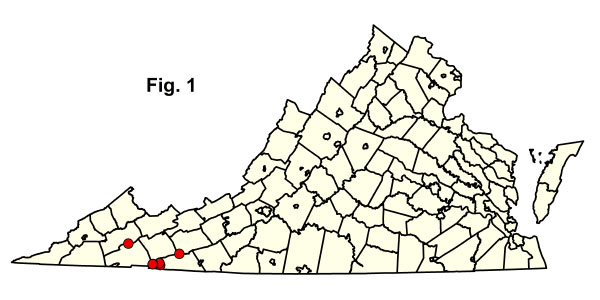

Virginia Department of Conservation and RecreationAn official website of the Commonwealth of Virginia Here's how you knowAn official websiteHere's how you know

Virginia Department of Conservation and RecreationAn official website of the Commonwealth of Virginia Here's how you knowAn official websiteHere's how you know
 Department of Conservation and Recreation
Department of Conservation and Recreation
 Table of Contents
Table of ContentsSouthern Appalachian Shrub and Grass Balds
Balds constitute a group of globally rare communities restricted to high-elevation (> 1,200 m [4,000 ft]) summits and upper slopes in the Southern Blue Ridge and Ridge and Valley, from Virginia south to northern Georgia. Dense, shrub-dominated balds are confined in Virginia to high rocky summits in the Mount Rogers - Whitetop Mountain area of Grayson, Smyth, and Washington Counties, and on a few caprock promontories of the Iron Mountains and Clinch Mountain. Three vegetation types are present: an evergreen shrubland dominated by Catawba rhododendron (Rhododendron catawbiense); a mixed shrubland of Catawba rhododendron, mountain laurel (Kalmia latifolia), black huckleberry (Gaylussacia baccata), and other species; and a deciduous shrubland dominated by American mountain-ash (Sorbus americana), minniebush (Menziesia pilosa), and southern mountain-cranberry (Vaccinium erythrocarpum). Very rocky, cold, windswept habitats probably contribute heavily to the creation and maintenance of shrub balds. At least some may have originated after catastrophic logging and fire disturbances almost a century ago, but even in these there is little or no evidence of tree reproduction.
In Virginia, Southern Appalachian Grassy Balds are represented by a single occurrence covering approximately 80 ha (200 ac) near the summit of Whitetop Mountain at the convergence of Grayson, Smyth, and Washington Counties. Vegetation of this site is dominated by mountain oatgrass (Danthonia compressa), sedges (Carex brunnescens, Carex flexuosa, Carex pensylvanica), and forbs such as three-toothed cinquefoil (Sibbaldiopsis tridentata) and Blue Ridge St. Johns-wort (Hypericum mitchellianum); several state-rare and globally rare species are present. The bald has been considerably disturbed and enlarged by human activities, but the presence of so many rare and light-demanding plants indicates that similar vegetation occurred here prior to these disturbances, most likely in the rockiest areas. The ecological dynamics that created and maintain this habitat are debatable, but probably include shallow rocky soils, fires, grazing, and microclimatic impacts such as frequent high-velocity winds and ice storms. Moreover, it is possible that the Whitetop bald represents a relict of true alpine vegetation that was more widely distributed at high elevations in the southern Appalachians during the Pleistocene.
Reference: Fleming and Coulling (2001), Weigl and Knowles (1999).
Click here for more photos of this ecological community group.
 © DCR-DNH, Gary P. Fleming.
© DCR-DNH, Gary P. Fleming.

 Download a spreadsheet of compositional summary statistics (Excel) for each of the community types listed below.
Download a spreadsheet of compositional summary statistics (Excel) for each of the community types listed below.

